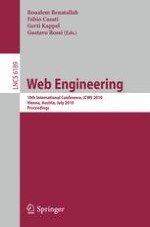2010 | Buch
Web Engineering
10th International Conference, ICWE 2010, Vienna Austria, July 5-9, 2010. Proceedings
herausgegeben von: Boualem Benatallah, Fabio Casati, Gerti Kappel, Gustavo Rossi
Verlag: Springer Berlin Heidelberg
Buchreihe : Lecture Notes in Computer Science
